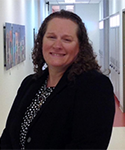Editor’s Note: The opinions expressed in this article are those of the author and do not necessarily reflect the opinions, positions, or the polices of the AAMC or its members.

Elizabeth Staib (Liz), LCSW, CEAP, SAP, joined Cooper Medical School of Rowan University in Camden, New Jersey, as the student support services specialist in 2018. Before CMSRU, she worked with the Inspira Behavioral Wellness Center in Glassboro, New Jersey, as an outpatient therapist. In her new role at CMSRU, she provides support, guidance, education, advocacy, and solution-focused counseling to medical students experiencing personal, emotional, and/or social challenges, as well as provides oversight to the CMSRU faculty and staff and Student Wellness Committees and serves as a key member of the Office of Student Affairs.
Being transgender in 2019 still carries many fears. More specifically, being a medical student who identifies as a trans person has multiple implications. Do I let people at the school know I identify as trans or queer? What microaggressions will I experience from faculty and peers? How do I offer the best medical care to my patients? How do I get the best medical care for myself, as a patient? Currently, it doesn’t seem medical schools are keeping up with the changing gender norms from a student well-being or patient care perspective.
Stanford University conducted a study published in 2015 titled “Sexual and Gender Minority Identity Disclosure During Undergraduate Medical Education: In the Closet in Medical School,” 176 medical schools in the US and Canada were surveyed about their students’ sexual identity, if they were “out,” and if not, why they chose to mask their identity. Of the 5,812 completed surveys, 920 students across 152 institutions identified as sexual and gender minority (SGM). Of those 912 identified as sexual minority, 29.5% concealed their sexual identity in medical school. In addition, 43.5% reported a fear of discrimination in medical school. Of the 35 who identified as gender minority, 60% concealed their identity for fear of discrimination and feeling a lack of support.
In another study conducted at Stanford University School of Medicine titled “Lesbian, Gay, Bisexual, and Transgender Medical Student Experiences: “Out” in Medical School and Perspectives on Curricular Content,” only five percent of medical students believed LGBTQIA+ physicians were seen as equals. Other data in this study mirrors the trends from Williams White’s presentation.
The obvious next question is what can be done to begin changing the medical school experience for transgender students? Cooper Medical School of Rowan University (CMSRU) staff heard the concerns about microaggressions, lack of proper education, and lack of sensitivity the transgender medical student community raised at their school. The CMSRU Office of Student Affairs organized the session Personalized Medicine: Transgender Perception What Every Doctor Needs to Know, understanding the obstacles of the transgender culture and emerging changes in health care, academic, and medical communities. This program was facilitated as a panel discussion and included a physician panelist who interacts with transgender patients, a trans man and advocate for the LGBTQIA+ community, and an undergraduate student who identifies as transgender. The panel discussion was aimed at educating the student body on language, pronouns, experiences, gender assignment at birth vs. sexual identity, and preferences of this specific community. It was an attempt to grow larger discussions and provide alternative viewpoints of those in attendance. Also, we hoped to raise self-awareness of prejudices and ignorance on this topic. Questions during the discussion were thoughtful and covered many perspectives. When the discussion ended, the panelists remained, and a majority of the audience raised additional questions with a sense of interest in learning more. Post-panel feedback from the CMSRU student body was very positive, and there were requests for similar sessions in the future. CMSRU is also in process of coordinating faculty development for their more than 500 faculty members, with a trans physician to facilitate this specific training for the CMSRU faculty.
Cooper Medical School of Rowan University is taking the initial steps to provide additional information surrounding transgender and other LGBTQIA+ issues, for students. The hope is for CMSRU to be a leader on this topic, to not only encourage an environment of inclusivity, but to graduate physicians who will provide the highest level of care and advocacy for their patients.
Elizabeth M. Staib, LCSW
Student Support Services Specialist
Cooper Medical School of Rowan University
For those seeking guidance, the AAMC created a resource that describes steps various key stakeholders can take. Be sure to also explore the AAMC Webinar Navigating the Residency Match as an LGBT Applicant.